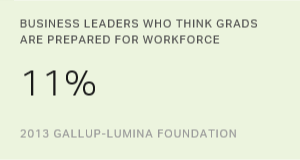There's a stark misalignment between the talents employers demand and the skills graduates have as they enter the U.S. workforce. And many higher education leaders fail to see it.
While 96% of chief academic officers of colleges and universities believe that their institutions are very or somewhat effective at preparing students for the workforce, only 11% of business leaders strongly agree.
This misalignment has critical implications for businesses. Companies in major industries report that they are unable to grow and compete because they struggle to identify properly skilled talent: 49% report unfilled job openings, and 37% can't take on a new project or major initiative.
It's not just businesses that recognize the disconnect between what companies need and what graduates know. Only 35% of college students say they are prepared for a job, and over half of recent graduates are unemployed or underemployed.
Among the general public, just 16% of Americans think that a four-year degree prepares students for a well-paying job in today's economy. And, in fact, a recent study by Gallup and Strada Education Network shows that 40% of bachelor's degree holders would study a different major if they could do it over again.
Yet, while the value of a college degree has increasingly been called into question, college enrollment rates at public higher education institutions have fallen by less than 2% each year since 2013. Meanwhile, as of 2017, 44 million Americans carry $1.3 trillion in student loan debt.
In short, millions of students enroll in postsecondary education programs and, in some cases, take on considerable student loan debt without the guarantee that their investment will result in a viable career.
How, then, do we set students up for success so that they can complete degree programs that lead to promising career pathways?
Strategies for Linking Education With Workforce Demands
In their report Learning to Work, Working to Learn, the U.S. Chamber of Commerce Foundation (USCCF) highlights best practices of higher education institutions that are working to realign education with the workforce. These case studies reveal several common strategies for building partnerships between employers and educators to help students enter the workforce better equipped to establish careers.
- Work-based learning: One successful strategy is to embed work-based learning into in-classroom and out-of-classroom experiences. In past research, Gallup has found that students who had internships where they could apply the knowledge and skills they were learning in the classroom are more likely to find full-time employment after college and to be engaged in their work. Work-based learning can happen on-campus as well, such as project-based or simulated experiences that take place on the school premises.
Maximizing the number of students who have the opportunity to participate in work-based learning requires a greater number of options and touchpoints over the course of a student's education. One particularly effective way to incorporate work-based learning in education programs is for companies to partner with an institution's career services office.
- Career services: Education leaders ought not to think of the student as the only customer of their work. In some ways, employer partners are just as important in identifying ways in which postsecondary training can lead to a good job. Just last year, Gallup found that though about half of U.S. college graduates report visiting the career services office at least once during their undergraduate experience, they are equally likely to say their experience was "not at all helpful" (16%) as they are to say it was "very helpful" (16%).
Staff brought on to career development teams need to create opportunities for long-lasting relationships with employers to benefit the students they serve. In addition, staff needs to be intimately familiar with what is happening across industries, including labor market information and what it reveals about in-demand jobs.
- Better information: This month, Gallup and Strada Education released a report showing that half of U.S. adults would change either their degree level, field of study or higher education institution. One implication is that students require better information about the outcomes of different education pathways. To highlight in-demand jobs available in a specific region or state and which programs provide good pathways to those jobs, USCCF partnered with American Institutes for Research and Gallup on the consumer information website Launch My Career.
Launch provides program-level outcomes data for first-time and full-time students, as well as working adults considering upskilling. Launch presents career awareness information as well as a practical exercise in which students can see for themselves how long it would take to achieve their lifestyle goals based on their program of study, purposefully tied to an ROI mindset.
Need a Focus on the Best Exit Strategies for Students
In recent decades, research and discussion about higher education have centered on college entrance -- who, how and where applicants gain admission to colleges and universities. However, as the 21st-century workforce evolves, so, too, must higher education. Rather than focusing exclusively on entrance into postsecondary education, we need a greater focus on the best exit strategies for students leaving education and entering the workforce.
In order to better align higher education and the workforce, businesses and education institutions can partner together to ensure that graduates enter the workforce prepared with the knowledge and skills they need to succeed.
Read the full report Learning to Work and Working to Learn.
